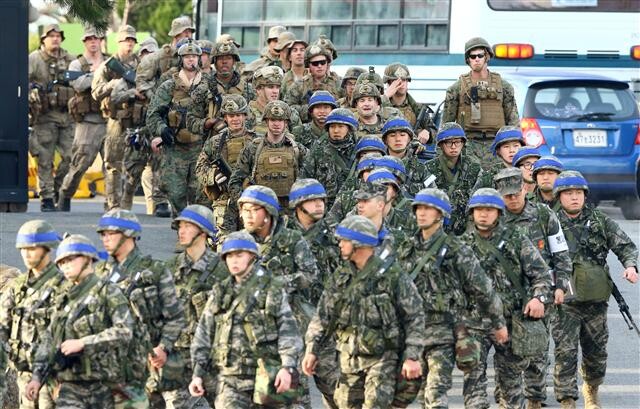hankyoreh
Links to other country sites 다른 나라 사이트 링크
“Decapitation strike” and N. Korea’s objections to ROK-US military drills

The key issue behind North Korea’s objections to the Key Resolve/Foal Eagle joint military exercises launched by South Korea and the US on Mar. 7 is the matter of the “decapitation strike” exercises. The heated response from Pyongyang appears to be a reaction to recent reports in the Japanese press that such a strike would be included in the exercises.
A decapitation strike or strategy is, quite literally, an operation to eliminate an enemy leader. In the past, the US military used state-of-the-art weaponry in operations to intended to take out leaders of anti-US administrations such as Saddam Hussein in Iraq or Muammar Gaddafi in Libya.
North Korea‘s own ambush of the Blue House on Jan. 21, 1968, could also be described as a primitive decapitation strike attempt. The North’s military could find it difficult to remain silent if the South Korean and US military train such a strike, since it would mean targeting the figure it calls its “supreme dignity”: leader Kim Jong-un.

The idea of a decapitation strike was first raised in South Korea around the late ’00s. Proponents like former Army Col. Kwon Tae-joon suggested the approach as part of military innovations. The issue became a source of controversy for the military after current Army brigadier general and Ministry of National Defense military reform officer Cho Sang-ho mentioned it alongside psychological warfare, intelligence supremacy, and precision strike capabilities as an example of asymmetrical strategy against the North at an Aug. 2015 academic seminar.
Cho later explained that he had “only cited an example of a concept that is being discussed academically” and “did not intend to suggest that such operations exist in the military.”
The reason the issue is once again touching off controversy is because of recent reports that the current exercises will adopt the operational concept of a pre-emptive strike in the event of a perceived imminent North Korean nuclear attack. One question is whether the potential targets for such a strike would include not only nuclear and missile bases, but also the offices of Kim, the figure who would be ordering an attack. Further fueling the speculation is the fact that the exercises are set to include the US 1st Special Forces Group and special operations troops with the 75th Ranger Regiment, which have previously been involved in decapitation strike operations. With the assassination of key enemy figures often included as one of the tasks of special operations units, the possibility of training for a decapitation strike cannot be ruled out.
A Ministry of National Defense official issued a de facto denial of the reports in a Mar. 7 briefing.
“The term ‘decapitation strike’ does not exist in the Ministry’s operational concepts,” the official said.
But when asked if a decapitation strike would be included in the exercises, the same official said he could “not speak about the content of the exercises.” For now, the ministry appears to opting for ambiguity rather than issuing a definite confirmation or denial.
By Park Byong-su, senior staff writer
Please direct questions or comments to [english@hani.co.kr]

Editorial・opinion
![[Column] Park Geun-hye déjà vu in Yoon Suk-yeol [Column] Park Geun-hye déjà vu in Yoon Suk-yeol](https://flexible.img.hani.co.kr/flexible/normal/500/300/imgdb/original/2024/0424/651713945113788.jpg) [Column] Park Geun-hye déjà vu in Yoon Suk-yeol
[Column] Park Geun-hye déjà vu in Yoon Suk-yeol![[Editorial] New weight of N. Korea’s nuclear threats makes dialogue all the more urgent [Editorial] New weight of N. Korea’s nuclear threats makes dialogue all the more urgent](https://flexible.img.hani.co.kr/flexible/normal/500/300/imgdb/original/2024/0424/7317139454662664.jpg) [Editorial] New weight of N. Korea’s nuclear threats makes dialogue all the more urgent
[Editorial] New weight of N. Korea’s nuclear threats makes dialogue all the more urgent- [Guest essay] The real reason Korea’s new right wants to dub Rhee a founding father
- [Column] ‘Choson’: Is it time we start referring to N. Korea in its own terms?
- [Editorial] Japan’s rewriting of history with Korea has gone too far
- [Column] The president’s questionable capacity for dialogue
- [Column] Are chaebol firms just pizza pies for families to divvy up as they please?
- [Column] Has Korea, too, crossed the Rubicon on China?
- [Correspondent’s column] In Japan’s alliance with US, echoes of its past alliances with UK
- [Editorial] Does Yoon think the Korean public is wrong?
Most viewed articles
- 1‘We must say no’: Seoul defense chief on Korean, USFK involvement in hypothetical Taiwan crisis
- 2Will NewJeans end up collateral damage in internal feud at K-pop juggernaut Hybe?
- 3[Column] Park Geun-hye déjà vu in Yoon Suk-yeol
- 4Why Korea shouldn’t welcome Japan’s newly beefed up defense cooperation with US
- 5Thursday to mark start of resignations by senior doctors amid standoff with government
- 6N. Korean hackers breached 10 defense contractors in South for months, police say
- 7[Guest essay] The real reason Korea’s new right wants to dub Rhee a founding father
- 8[Column] ‘Choson’: Is it time we start referring to N. Korea in its own terms?
- 9Kim Jong-un expressed ‘satisfaction’ with nuclear counterstrike drill directed at South
- 10[Editorial] New weight of N. Korea’s nuclear threats makes dialogue all the more urgent